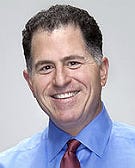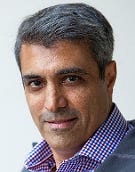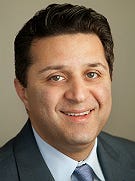The CP List: 20 Tech Channel Thought Leaders You Should KnowThe CP List: 20 Tech Channel Thought Leaders You Should Know
Our list includes company executives, analysts, evangelists and strategists.

When they speak, people stop and listen.
They’re the people who take a big-picture view when it comes to technology, where it’s heading and the impact it will have on the channel. They’re in telecom, cybersecurity, data management and storage, and other technologies.
Our list includes company executives, analysts, evangelists and strategists.
They all come from different backgrounds, but they’re united in their focus on the future of technology.
Scroll through our list of 20 top tech thought leaders to follow:
Dina Moskowitz

SaaSMax’s Dina Moskowitz
Dina Moskowitz, CEO of SaaSMax, said from her seat at the table, “I can see that innovations are coming to the channel in the form of distribution and commerce platforms that make it easier, more operationally efficient and thus more profitable for channel partners to do business with providers of SaaS and cloud software.”
“That means channel partners can and will be able to partner with more and more innovative SaaS products, build better solution sets for their clients and add new monthly recurring revenue (MRR) income streams to their own businesses,” she said. “According to calculations at SaaSMax, the overall impact will be that the channel has the opportunity to drive more than $50 billion in new SaaS revenues by 2024.”
Ansley Hoke
Ansley Hoke, vice president of merchandising at ScanSource Catalyst, said AI and IoT will play a big role in new product and solution offerings.

ScanSource Catalyst’s Ansley Hoke
“Manufacturing will likely further embrace IoT and become more sensor-driven in an effort to better manage inventory, decrease delays in product manufacturing, and improve response times in critical situations,” she said. “IoT-enabled devices on the network will grow exponentially, requiring more bandwidth, better reliability and greater connectivity. This move toward IoT will lead to a stronger push for 5G connectivity from service providers.”
As for AI, it will become an important factor in analyzing big data in order to identify market trends, predict equipment and system failures, and automate simple human tasks, Hoke said.
“AI devices will become more common, assisting users in homes, cars and in the office,” she said. “There is great opportunity for the channel to embrace IoT and AI, and become well-versed on how these technologies can help their customers improve their business processes.”
(continued on next page)
Michael Dell

Dell’s Michael Dell
When Michael Dell, Dell Technologies’ CEO and chairman, took the stage at this year’s Dell Technologies World conference, he told attendees they share a “vision of a future that is better than today,” and a vision of technology “as the driver of human progress.” Thirty-four years ago, he founded PC’s Limited, which would be renamed Dell, and in 1992 he became the youngest CEO on the Fortune 500 list.
“At first, the power of digital transformation was kind of like a secret that only we in the technology world saw coming,” he said. “Fast-forward a few years and the secret of digital transformation has burst onto the public consciousness. Every customer that I meet is re-imagining how they use technology in every aspect of their operations to drive growth, new business models, customer relationships, and new products and services. Technology is now at the very top of the agenda for business leaders everywhere and for the C-suite.”
Parisa Tabriz
Parisa Tabriz, Google’s director of engineering, told attendees at this summer’s Black Hat conference that great strides have been made in fighting cybercriminals during the past decade, but to be successful, “we have to stop playing whack-a-mole” and do a better job of identifying and tackling the root cause of cyber threats.

Google’s Parisa Tabriz
She also said it’s important to pick milestones and celebrate them, and build out your coalition of experts.
Tabriz is responsible for Chrome security and Project Zero, a security research team tasked with reducing harm associated with zero-day vulnerabilities.
“Making real change is hard; it results in pushback,” she said. “Making fundamental change to the status quo is hard. If you’re not upsetting anyone, you’re not changing the status quo.”
(continued on next page)
Dave Sobel

SolarWinds MSP’s Dave Sobel
Dave Sobel, SolarWinds MSP’s director of MSP evangelism, is always focused on tomorrow, and said artificial intelligence (AI) is going to have the greatest impact on the channel in the next year.
“Systems continue to become more and more intelligent, offering insights that give humans the ability to make better decisions than ever before,” he said. “Just as we are seeing artificial intelligence (AI) drive successful outcomes in health care and in manufacturing, it will bring the ability for channel organizations to be more efficient with access to greater insights. One of AI’s promises is in bringing data insights that humans have difficulty getting on their own, particularly across very large data sets. With successful channel companies providing more and more business consulting and driving to business outcomes, these insights will be more and more impactful.”
Jeff Moss

Black Hat’s Jeff Moss
Jeff Moss, Black Hat founder and director, told attendees at this year’s conference that it feels like the industry is in the final exam stage to prove “if we’re as good as we say we are.” He also said the technology being developed is mostly offensive, while cybersecurity defense is becoming increasingly political.
Maybe 20 companies globally are in a position to do something about raising “security resiliency for all of us,” Moss said. It’s up to everyone else in cybersecurity to put pressure on those companies to get those features, he said.
(continued on next page)
Mark J. Barrenechea
Mark J. Barrenechea, OpenText’s vice chairman, CEO and CTO, said industrial AI, the combination of IoT and AI, will have a big impact on the channel over the next year.

OpenText’s Mark Barrenechea
“Ten billion smart machines will connect to the internet, more machines than humans,” he said. “Industrial companies (will be) using AI to understand supply chain behavior, transportation, inventories, demand and production. The machine will understand your next behavior before you do, and will have already moved inventory and supply chain to deliver to you instantly. We will no longer choose our friends on Facebook. We will no longer choose our movies on Netflix, we will no longer choose our consumer goods on Amazon. The machine will. But will the machine choose the partner as well!”
Jon Arnold
Arnold, principal analyst at J Arnold & Associates, always provides both a history lesson and a look ahead when asked asked about various technology and channel trends.

Jon Arnold
“At this point, it’s a given that cloud is pushing channels to adopt SaaS business models,” he said. “This may not be impacting the channel in a big way yet, but will eventually replace business models based on hardware-based capex investments. Innovations around AI will also have a major impact on the channel, but that’s still emerging. For the next year or so, the more market-ready innovations will come from CPaaS offerings, where developer-friendly channel partners can white label vertical applications or platforms that are customized for specific market segments. CPaaS provides great flexibility to embed communications capabilities into other applications or processes, and channels that are comfortable with APIs can offer new forms of value to businesses that need innovation now, but have too many constraints to produce that internally.”
(continued on next page)
Jo Peterson

Clarify360’s Jo Peterson
Jo Peterson, vice president of cloud services at Clarify360 and Cloud Girls‘ co-founder, said market consolidation from a vendor perspective is “white hot.” Cloud Girls’ new focus is on thought leadership.
“As big companies get even bigger, adding to their internal sales teams and treating partners as competition, it’s important to ensure that your contracts provide as much protection as possible,” she said. “Creating and maintaining direct relationships with key vendor leadership is also imperative in this quickly changing landscape.”
We’re also seeing a shift in customer buying patterns to “total, often complex solutions instead of point products,” Peterson said.
“The market is shifting to online buying due to convenience and expediency,” she said. “According to 2112’s Channel Chief Outlook report, 11 percent of channel executives expect the majority of their revenue to come through automated digital sales by 2023. Channel partners must continue to drive value for clients around tools, analysis, integration, implementation and the expertise they bring to the table.”
Marc McClure
Marc McClure, Tech Data’s senior vice president of U.S. commercial sales, said the pace of innovation around cloud feature sets and cloud infrastructure creates “one of the best opportunities for the channel that we have seen since the onset of managed services.”

Tech Data’s Mark McClure
“In an era when many felt that cloud would disintermediate the traditional IT provider, we are seeing the opposite effect,” he said. “As end companies are transitioning their infrastructure over to multicloud environments in order to create platforms from which to launch their digital-transformation initiatives, we are also witnessing a rapid increase in cloud features being created by hyperscale cloud providers like AWS and Azure. Identifying and mapping the features that make the most sense for those end companies is no simple task. As such, this challenge represents a tremendous opportunity for consultative engagements from solution providers to not only help identify which features make the most sense (driven by needs ranging from workload types to vertical applications), but also an opportunity for workload prioritization, planning and migration services.”
(continued on next page)
Todd Weber

Optiv Security’s Todd Weber
Todd Weber, Optiv‘s vice president of partner research and strategy, expects big things for security operations platforms.
“We’ll see security operations platforms consolidate to include security orchestration and automation, full packet analysis, flow analysis, log analysis, big data, threat intelligence, user behavior analytics and automated response functions,” he said. “This will change people’s view on traditional security information and event management (SIEM) technologies and how they fit into security models. This consolidation is important for the industry, as it should free up man-hours, increase response times, and improve efficacy of security operations.”
(continued on next page)
Raul Castanon-Martinez

451 Research’s Raul Castanon-Martinez
Raul Castanon-Martinez, senior analyst at 451 Research, said the one innovation he expects will have the biggest impact for the channel is the voice interface.
“Speech recognition has been around for a long time, even before Apple made it mainstream when it launched Siri with the iPhone 4S in October 2011,” he said. “There are signs that voice is rapidly emerging as the main user interface for many applications and devices. Speech recognition and natural language understanding will change how we interact with computers, devices and appliances. This opens many opportunities for innovation in human-computer interaction (HCI). This will require a good understanding of how organizations can benefit from redesigning workflows and processes to incorporate voice interactions for employee and customer engagement, and the channel community is uniquely positioned to make this happen.”
(continued on next page)
Tina Gravel

Cyxtera’s Tina Gravel
Tina Gravel, Cyxtera‘s senior vice president of global channels and alliances, describes herself as a “cloud pioneer.”
“I was working to get cloud adopted by the channel 10 years ago when I was at Terremark,” she said.
Next year through 2020, 5G and its impact on mobile applications will have a “huge impact on the channel,” Gravel said.
(continued on next page)
Michael Suby

Frost & Sullivan’s Michael Suby
Michael Suby, Stratecast vice president of research at Frost & Sullivan, is always focused on the bigger picture when it comes to M&A and cybersecurity. Earlier this year, he told us that demand is steadily growing for managed detection and response (MDR) and threat hunting.
“It’s that idea of, ‘Look, we know we are probably compromised in some way or we will be compromised in some way, but right now we don’t have either the technology, the know-how or the personnel to detect what’s going on, understand what’s going on and then take action,’ and then do all of that in a faster time frame than the attackers can run through the course of their exploits, which in many cases is exfiltrating data,” he said. “You’ve got to be on your toes 24/7.”
(continued on next page)
Michelle Ruyle

Optimized Channel’s Michelle Ruyle
Michelle Ruyle, CEO of Optimized Channel, works as an adviser to both regional and national firms that are looking to create, augment or redesign their channel strategy in the cloud space. She is a founding member of Cloud Girls, and has many years tenure in cloud, first as a channel director for Softlayer and then in numerous cloud roles in both the health care and finance verticals for IBM after its purchase of Softlayer.
“With a deep understanding of the entire sales cycle both from the consulting side and the provider side of the table, Michelle helps both parties see clearly across the cloud,” Jo Peterson said.
(continued on next page)
Christina Richmond

IDC’s Christina Richmond
Christina Richmond, program vice president for IDC’s security services research practice, is responsible for IDC’s worldwide research and analysis on enterprise and service provider security consulting and integration services. She identifies trends and analyzes strategies that are key to the success of the security-focused IT suppliers, global SIs and service providers.
(continued on next page)
Dave Venable

Masergy’s Dave Venable
Dave Venable, Masergy’s vice president of cybersecurity, is a security thought leader, public speaker, educator and former intelligence professional with more than 20 years of experience in information security and risk management in both the public and private sectors. He recently addressed threats against energy and critical infrastructure.
(continued on next page)
Ameesh Divatia

Baffle’s Ameesh Divatia
Ameesh Divatia, CEO of advanced data protection company Baffle, knows all about data storage and where this technology is heading, and channel impact.
“The age of fast-moving digital transformation and data security requires channel partners to redefine who they work with,” he said. “Today’s data sharing is breaking down traditional silos, yet outdated security methods remain stuck in silos and ineffective for big-data analytics and the cloud. In fact, Gartner says that by 2020, data-centric audit and protection products will replace disparate siloed data security tools in 40 percent of large enterprises, up from less than 5 percent today.”
Encryption has been “too complicated to deploy and manage,” wasn’t designed for the scale and diversity of big data and the cloud — and is “notorious for breaking applications,” Divatia said.
“Channel partners should work with vendors that are disrupting the status quo to aggressively create and innovate to meet these changing demands of the IT market,” he said. “The impact will be from vendors that can take this data-centric approach and enable owners of sensitive data to be in control of it at all times – at rest, in memory and in use – irrespective of it being on-premise[s] or in the cloud.
(continued on next page)
Tamara Prazak

Flexential’s Tamara Prazak
Tamara Prazak, Flexential‘s director of channel strategy, has nearly 20 years of experience in technology, with nearly a decade working in cloud. She said edge computing represents a “huge opportunity” for channel partners.
“Market trends such as the confluence of growing demand in streaming content, the explosive growth of IoT devices and the end-user customers’ requirements for low latency and high-availability connectivity are driving demand for edge computing,” she said. “The opportunities for the channel to help customers with edge computing solutions are vast, spanning network connectivity, edge data-center services and cloud computing. The trend is to complement centralized data-center solutions with edge data center and cloud deployments closer to end users. Partners should be skilled at building solutions that take into account the latency requirements, geography, cost and security needs to meet their clients’ business objective and leverage this tremendous market opportunity to increase their revenue and reinforce their trusted-adviser status.”
(continued on next page)
Barmak Meftah
Barmak Meftah, president of AT&T Cybersecurity Solutions and CEO of AlienVault, has more than 20 years of experience in enterprise software. AT&T acquired AlienVault this summer.

AT&T’s Bartak Meftah
Under Meftah’s leadership since 2011, AlienVault has become one of the fastest growing security vendors in the industry with thousands of customers and partners around the world. Prior to AlienVault, he served as vice of HP’s enterprise security products. At HP he led the Fortify and SPI Dynamics business units after the successful acquisition of Fortify by HP in September 2010.
“The oscillation you’ll go through as an entrepreneur, the highs are extraordinary and the lows, I can’t even begin to tell you how low they are,” Meftah said in a GGV Capital Founder Real Talk podcast. “And your ability as an entrepreneur and a CEO [is] to be able to ride those highs, don’t get too excited when things are going great, and don’t get too dark and morose when things aren’t going too great.”
Read more about:
AgentsAbout the Author
You May Also Like


